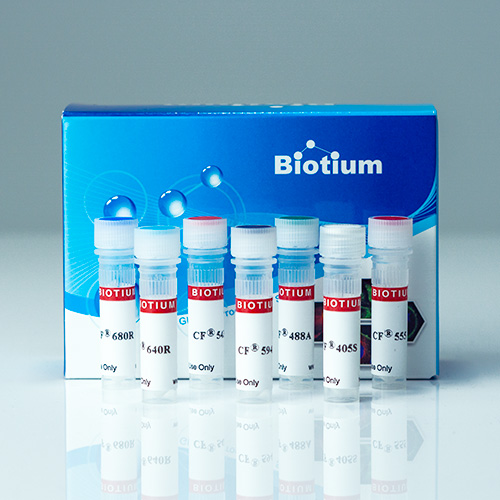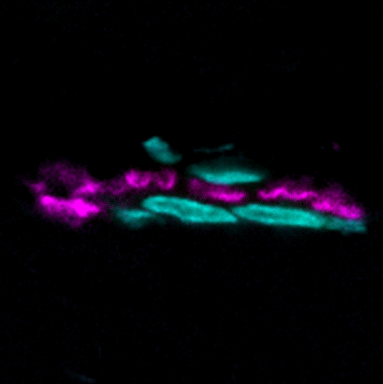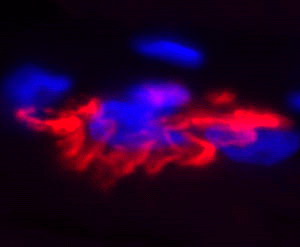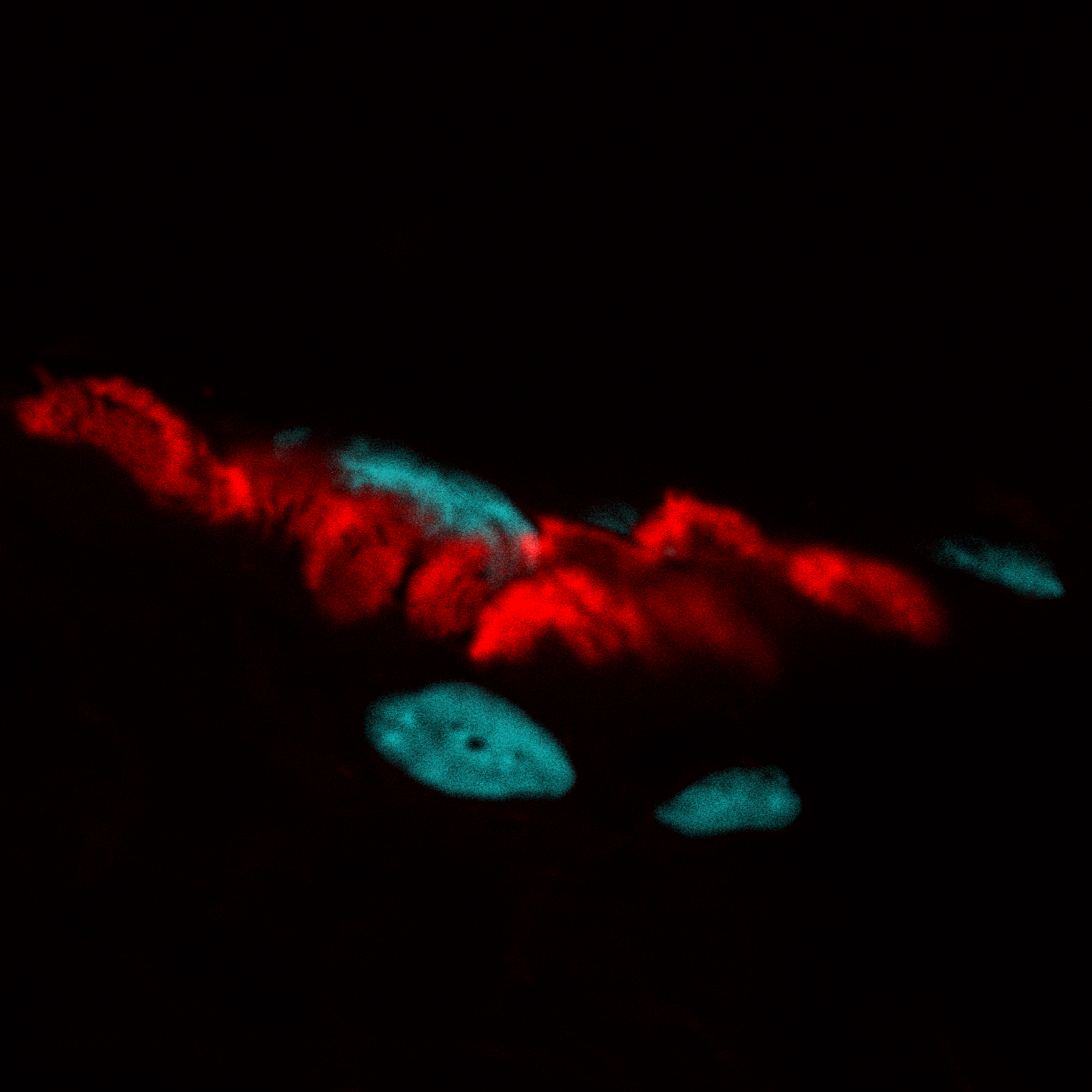α-Bungarotoxin, CF® Dye and Other Conjugates
Conjugates of α-Bungarotoxin labeled with a selection of our CF® Dyes and other labels. Labeled α-bungarotoxin conjugates can be used for staining nicotinic acetylcholine receptors at neuromuscular junctions in tissue sections.
Wishlist updated! View wishlist
Product Description
Alpha-bungarotoxin is a polypeptide snake toxin that binds to the nicotinic acetylcholine receptor found at the neuromuscular junction with high affinity. Fluorescent alpha-bungarotoxin can be used for labeling of nicotinic acetylcholine receptors at neuromuscular junctions in tissue sections. Alpha-bungarotoxin may also be used for detection of GABA A receptor subsets in cells (1), or for labeling recombinant proteins that express the alpha-bungarotoxin binding site (BBS) epitope tag (2).
- Choose from 9 bright and stable CF® Dye colors or other labels
- Dye options for super-resolution and 2-photon imaging
We also offer Biotin-XX-alpha-bungarotoxin (catalog. no. 00017), and unconjugated alpha-bungarotoxin.(catalog no. 00010-1). See our complete selection of alpha-Bungarotoxins below.
Superior CF® Dyes
Biotium’s next-generation CF® dyes were designed to be highly water-soluble with advantages in brightness and photostability compared to Alexa Fluor®, DyLight®, and other fluorescent dyes. Learn more about CF® Dyes.
Note: Conjugates of blue-fluorescent dyes like CF®350, CF®405S and CF®405M are not recommended for detecting low abundance targets and may be challenging to use in tissue specimens. Blue dyes have lower fluorescence and photostability, and cells and tissue have high autofluorescence in blue wavelengths, resulting in lower signal to noise compared to other colors.
Super-Resolution Microscopy
Many CF® Dyes are compatible with super resolution imaging, CF® Dyes give the best performance for multiple methods. The superior brightness, photostability, and photochemical switching properties of certain CF® Dyes are ideal for 3-D SIM, 3-D STORM, and other super-resolution and single-molecule imaging approaches. Learn more about CF® Dyes for super-resolution microscopy.
α-Bungarotoxin, CF® Dye and Other Conjugates
| Conjugation | Ex/Em | Size | Catalog No. | Dye Features |
|---|---|---|---|---|
| Unconjugated | N/A | 1 mg | 00010-1 | |
| Biotin-XX | N/A | 0.5 mg | 00017 | |
| CF®405S | 411/431 nm | 100 ug | 00002-100ug | CF®405S Features |
| 0.5 mg | 00002 | |||
| CF®488A | 490/516 nm | 100 ug | 00005-100ug | CF®488A Features |
| 0.5 mg | 00005 | |||
| CF®543 | 543/563 nm | 100 ug | 00026-100ug | CF®543 Features |
| 0.5 mg | 00026 | |||
| CF®555 | 554/568 nm | 100 ug | 00018-100ug | CF®555 Features |
| 0.5 mg | 00018 | |||
| CF®568 | 562/584 nm | 100 ug | 00006-100ug | CF®568 Features |
| 0.5 mg | 00006 | |||
| CF®594 | 593/615 nm | 100 ug | 00007-100ug | CF®594 Features |
| 0.5 mg | 00007 | |||
| CF®633 | 629/650 nm | 100 ug | 00009-100ug | CF®633 Features |
| 0.5 mg | 00009 | |||
| CF®640R | 642/663 nm | 100 ug | 00004-100ug | CF®640R Features |
| 0.5 mg | 00004 | |||
| CF®680R | 680/701 nm | 100 ug | 00003-100ug | CF®680R Features |
| 0.5 mg | 00003 | |||
| Fluorescein (FITC) | 498/517 nm | 0.5 mg | 00011 | |
| 10 x 50 ug | 00013 | |||
| Tetramethylrhodamine (TRITC) | 552/578 nm | 0.5 mg | 00012 | |
| 10 x 50 ug | 00014 | |||
| Sulforhodamine-101 (Texas Red®) | 595/613 nm | 0.5 mg | 00015 | |
| 10 x 50 ug | 00016 |
References
- PNAS, 103, 13, (2006), DOI: 10.1073/pnas.0600847103
- Meth. Enzymol., 521, (2013), DOI: 10.1016/B978-0-12-391862-8.00006-5
- Sci Adv, 6, 15, (2020), DOI: 10.1126/sciadv.aax8382
- Am J Physiol Cell Physiol, (2020) DOI: 10.1152/ajpcell.00453.2019
- Biochem Biophys Res Commun., 523, 214, (2020), DOI: 10.1016/j.bbrc.2019.12.011
- Front Cell Dev Biol., 8, 15, (2020), DOI: 10.3389/fcell.2020.00015
- Biophysics, 64, 772, (2019), DOI: 10.1134/S0006350919050129
- Cell Physiol Biochem, 53, 701, (2019), DOI: 10.33594/000000166
- Biochemistry (Mosc.), 4, 1085, (2019), DOI: 10.1134/S0006297919090116
- Biomaterials, 225, 119537, (2019), DOI: 10.1016/j.biomaterials.2019.119537
- ACS Chem. Biol., 13, 2568, (2018), DOI: 10.1021/acschembio.8b00513
- Cell Mol Neurobiol, 37, 1443, (2017), DOI: 10.1007/s10571-017-0475-3
- Neuroscience, 174, 234, (2011), DOI: 10.1016/j.neuroscience.2010.11.016
- Am J of Pathol, 177, 2509 (2010), DOI: 10.2353/ajpath.2010.100243
- Cell Tissue Biol, 4, 258, (2010), DOI: 10.1134/S1990519X10030077
- Neuroscience, 174, 234, (2009), DOI: 10.1016/j.neuroscience.2010.11.016
- J Cell Biol, 150, 1385, (2000), DOI: 10.1083/jcb.150.6.1385
- Neuron, 23, 675, (1999), DOI: 10.1016/s0896-6273(01)80027-1
- Neuron, 12, 167, (1994), DOI: 10.1016/0896-6273(94)90161-9
- J Cell Biol, 125, 661, (1994), DOI: 10.1083/jcb.125.3.661
- J Biol Chem, 268, 25108, (1993), PMID: 8227074
- Muscle Nerve, 5, 140, (1982), DOI: 10.1002/mus.880050211
- PNAS 77, 4823, (1980), DOI: 10.1073/pnas.77.8.4823
- Science, 196, 540, (1977), DOI: 10.1126/science.850796
Download a list of CF® dye references.





